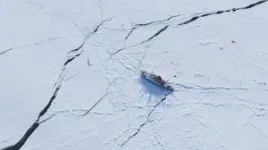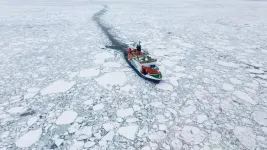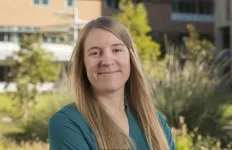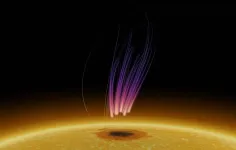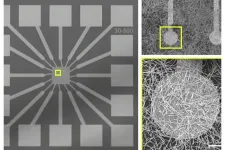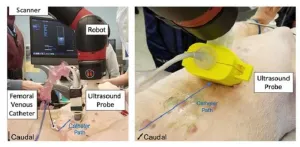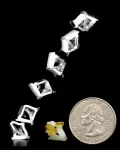(Press-News.org) A few decades ago, seismologists imaging the deep planet identified a thin layer, just over a few hundred kilometers thick. The origin of this layer, known as the E prime layer, has been a mystery — until now.
An international team of researchers, including Arizona State University scientists Dan Shim, Taehyun Kim and Joseph O’Rourke of the School of Earth and Space Exploration, has revealed that water from the Earth's surface can penetrate deep into the planet, altering the composition of the outermost region of the metallic liquid core and creating a distinct, thin layer. Illustration of silica crystals coming out from the liquid metal of the Earth's outer core due to a water-induced chemical reaction.
Their research was recently published in Nature Geoscience.
Research indicates that over billions of years, surface water has been transported deep into the Earth by descending, or subducted, tectonic plates. Upon reaching the core-mantle boundary, about 1,800 miles below the surface, this water triggers a profound chemical interaction, altering the core’s structure.
Along with Yong Jae Lee of Yonsei University in South Korea, Shim and his team have demonstrated through high-pressure experiments that subducted water chemically reacts with core materials. This reaction forms a hydrogen-rich, silicon-depleted layer, altering the topmost outer core region into a film-like structure. Additionally, the reaction generates silica crystals that rise and integrate into the mantle. This modified liquid metallic layer is predicted to be less dense, with reduced seismic velocities, in alignment with anomalous characteristics mapped by seismologists.
Illustration of Earth’s interior revealing subducting water and a rising plume of magma. At the interface where subducting water meets the core, a chemical exchange occurs to form a hydrogen-rich layer in the topmost outer core and dense silica in the bottom of the mantle. Image courtesy Yonsei University
“For years, it has been believed that material exchange between Earth's core and mantle is small. Yet, our recent high-pressure experiments reveal a different story. We found that when water reaches the core-mantle boundary, it reacts with silicon in the core, forming silica," said Shim. "This discovery, along with our previous observation of diamonds forming from water reacting with carbon in iron liquid under extreme pressure, points to a far more dynamic core-mantle interaction, suggesting substantial material exchange.”
This finding advances our understanding of Earth's internal processes, suggesting a more extensive global water cycle than previously recognized. The altered "film" of the core has profound implications for the geochemical cycles that connect the surface-water cycle with the deep metallic core.
This study was conducted by an international team of geoscientists using advanced experimental techniques at the Advanced Photon Source of Argonne National Lab and PETRA III of Deutsches Elektronen-Synchrotron in Germany to replicate the extreme conditions at the core-mantle boundary.
Members of the team and their key roles from ASU are Kim, who began this project as a visiting PhD student and is now a postdoctoral researcher at the School of Earth and Space Exploration; Shim, a professor at the School of Earth and Space Exploration, who spearheaded the high-pressure experimental work; and O’Rourke, an assistant professor at the School of Earth and Space Exploration, who performed computational simulations to comprehend the formation and persistence of the core's altered thin layer. Lee led the research team from Yonsei University, along with key research scientists Vitali Prakapenka and Stella Chariton at the Advanced Photon Source and Rachel Husband, Nico Giordano and Hanns-Peter Liermann at the Deutsches Elektronen-Synchrotron.
END
Earth's surface water dives deep, transforming core's outer layer
ASU researchers contribute to discovery revealing more dynamic core-mantle interaction than previously known
2023-11-14
ELSE PRESS RELEASES FROM THIS DATE:
Faster Arctic warming hastens 2C rise by eight years
2023-11-14
Faster warming in the Arctic will be responsible for a global 2C temperature rise being reached eight years earlier than if the region was warming at the average global rate, according to a new modelling study led by UCL researchers.
The Arctic is currently warming nearly four times faster than the global average rate. The new study, published in the journal Earth System Dynamics, aimed to estimate the impact of this faster warming on how quickly the global temperature thresholds of 1.5C and 2C, set down in the Paris Agreement, are likely to be breached.
To do this, the research team created alternative ...
New 'library of greening' can help poorest urban communities the most, Surrey expert says
2023-11-14
Surrey scientists are celebrating with colleagues around the world, after winning new funding for a ‘library of greening’ – a new database enabling towns and cities to learn from each other's success developing green spaces, waterways and other sustainability initiatives.
The RECLAIM Network Plus provides a one-stop-shop for towns and cities looking to mitigate the impacts of climate change and improve their resilience. It has over 500 members worldwide, offering information and support to implement projects such as ...
New antiphospholipid syndrome research findings presented at ACR Convergence 2023
2023-11-14
Investigators from the Antiphospholipid Syndrome Alliance for Clinical Trials and International Networking (APS ACTION) presented new research findings in antiphospholipid syndrome (APS) at the American College of Rheumatology (ACR) Convergence 2023, the ACR’s annual meeting.
Hospital for Special Surgery (HSS), one of the leading centers in the United States providing care for adults and children with APS, is the lead coordinating center for APS ACTION, an international research network of 34 academic institutions dedicated to advancing the understanding and management of APS. APS ACTION conducts large, ...
UTA developing more powerful rocket engines for space travel
2023-11-14
A University of Texas at Arlington engineering researcher has received a NASA grant to use rotating detonation rocket engines (RDREs) for in-space propulsion to make them more efficient, compact and powerful.
Liwei Zhang, an assistant professor in the Department of Mechanical and Aerospace Engineering (MAE), will lead the $900,000 grant.
“Detonation is very fast combustion. Inside an RDRE, detonation waves spin around in a circle at supersonic speeds. Compared to conventional engines that rely on regular combustion, an RDRE has a theoretically ...
A how-to for reducing flooding impacts in coastal towns
2023-11-14
A University of Texas at Arlington civil engineering researcher is determining what strategies are most effective at lessening flooding in coastal communities.
Michelle Hummel, a civil engineering assistant professor, is using a $499,973 National Oceanic and Atmospheric Administration (NOAA) grant to study the benefits and costs of flood-reduction strategies aimed at increasing coastal resilience to storms and sea-level rise.
Hummel and her colleague, Kevin Befus of the University of Arkansas, will apply advanced ...
NJIT scientists uncover aurora-like radio emission above a sunspot
2023-11-13
In a study published in Nature Astronomy, astronomers from New Jersey Institute of Technology’s Center for Solar-Terrestrial Research (NJIT-CSTR) have detailed radio observations of an extraordinary aurora-like display — occurring 40,000 km above a relatively dark and cold patch on the Sun, known as a sunspot.
Researchers say the novel radio emission shares characteristics with the auroral radio emissions commonly seen in planetary magnetospheres such as those around Earth, Jupiter and Saturn, as well as certain low-mass stars.
The discovery offers new insights into the origin of such intense solar radio bursts and potentially opens new avenues ...
Experimental brain-like computing system more accurate with custom algorithm
2023-11-13
FINDINGS
An experimental computing system physically modeled after the biological brain “learned” to identify handwritten numbers with an overall accuracy of 93.4%. The key innovation in the experiment was a new training algorithm that gave the system continuous information about its success at the task in real time while it learned.
The algorithm outperformed a conventional machine-learning approach in which training was performed after a batch of data has been processed, producing 91.4% accuracy. The researchers also showed that memory of past inputs stored in the system itself enhanced learning. In contrast, other ...
Researchers develop gel to deliver cancer drugs for solid tumors
2023-11-13
Intratumoral therapy – in which cancer drugs are injected directly into tumors – is a promising treatment option for solid cancers but has shown limited success in clinical trials due to an inability to precisely deliver the drug and because most immunotherapies quickly dissipate from the site of injection. A team of researchers from Mass General Brigham, in collaboration with colleagues at the Koch Institute for Integrative Cancer Research, has developed a gel delivery system that overcomes these challenges. The gel is injectable but solidifies upon delivery; contains an imaging agent for visualization under CT scan; and can hold a high ...
Using deep learning to process raw photoacoustic channel data and guide cardiac interventions
2023-11-13
Cardiovascular diseases rank among the top causes of death across the world, and cardiac interventions are similarly very common. For example, cardiac catheter ablation procedures, which are used to treat arrythmias, number in several tens of thousands per year in the US alone. In these procedures, surgeons insert a thin, flexible tube called a catheter into the femoral vein in the leg and navigate their way up to the heart, where the problematic tissue is destroyed using cold or focused radiation.
Even though cardiac catheter-based procedures are considered minimally invasive, the position ...
The Long Jump: Athletic, insect-scale long jumping robots reach where others can't.
2023-11-13
A team of engineers from the University of Illinois has published the first known study documenting the long-jumping motion of 3D-printed insect-scale robots.
The new study, published in the journal Smart Materials and Structures, follows a previous publication that documented the same lab’s investigation of vertical jumping in insect-scale robots. The study is led by Professor Sameh Tawfick, an associate professor and Ralph A. Andersen Faculty Scholar in the Department of Mechanical Science and Engineering. His lab, the Kinetic Materials Research Group, studies the ...
LAST 30 PRESS RELEASES:
Making lighter work of calculating fluid and heat flow
Normalizing blood sugar can halve heart attack risk
Lowering blood sugar cuts heart attack risk in people with prediabetes
Study links genetic variants to risk of blinding eye disease in premature infants
Non-opioid ‘pain sponge’ therapy halts cartilage degeneration and relieves chronic pain
AI can pick up cultural values by mimicking how kids learn
China’s ecological redlines offer fast track to 30 x 30 global conservation goal
Invisible indoor threats: emerging household contaminants and their growing risks to human health
Adding antibody treatment to chemo boosts outcomes for children with rare cancer
Germline pathogenic variants among women without a history of breast cancer
Tanning beds triple melanoma risk, potentially causing broad DNA damage
Unique bond identified as key to viral infection speed
Indoor tanning makes youthful skin much older on a genetic level
Mouse model sheds new light on the causes and potential solutions to human GI problems linked to muscular dystrophy
The Journal of Nuclear Medicine ahead-of-print tip sheet: December 12, 2025
Smarter tools for peering into the microscopic world
Applications open for funding to conduct research in the Kinsey Institute archives
Global measure underestimates the severity of food insecurity
Child survivors of critical illness are missing out on timely follow up care
Risk-based vs annual breast cancer screening / the WISDOM randomized clinical trial
University of Toronto launches Electric Vehicle Innovation Ontario to accelerate advanced EV technologies and build Canada’s innovation advantage
Early relapse predicts poor outcomes in aggressive blood cancer
American College of Lifestyle Medicine applauds two CMS models aligned with lifestyle medicine practice and reimbursement
Clinical trial finds cannabis use not a barrier to quitting nicotine vaping
Supplemental nutrition assistance program policies and food insecurity
Switching immune cells to “night mode” could limit damage after a heart attack, study suggests
URI-based Global RIghts Project report spotlights continued troubling trends in worldwide inhumane treatment
Neutrophils are less aggressive at night, explaining why nighttime heart attacks cause less damage than daytime events
Menopausal hormone therapy may not pose breast cancer risk for women with BRCA mutations
Mobile health tool may improve quality of life for adolescent and young adult breast cancer survivors
[Press-News.org] Earth's surface water dives deep, transforming core's outer layerASU researchers contribute to discovery revealing more dynamic core-mantle interaction than previously known

